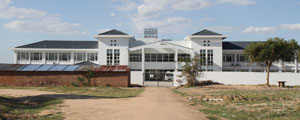
Residents in Mahusekwa are waiting with bated breath for the official opening of the new state-of-the-art referral hospital built by the Chinese at Mahusekwa business centre, 70km east of Harare.
Report by Phillip Chidavaenzi
During a recent visit to the area, NewsDay established that the 200-bed referral hospital could mark the beginning of a significant facelift of the otherwise rustic outpost.
Conrad Huva, who works in one of the shops at the business centre, said many people in the area were excited about the project which they believe will put Mahusekwa on the map.
“We are very excited,” he said. “We are looking forward to the time when this hospital will open its doors and we believe it will give good services just like Howard and Murambinda.”
Howard Hospital in Chiweshe and Murambinda Hospital are renowned for top-of-the-line services backed by state-of-the-art equipment that has seen people driving from as far as Harare, Mutare and Bulawayo to seek treatment.
Mahusekwa Hospital, also known as China and Zimbabwe Friendship Hospital, is a China Economic Aid Project in Zimbabwe, according to the project manager Ling Jinxiang.
Jinxiang said the hospital — which covers 17 000 square metres with built-on area of up to 7 219 square metres — was constructed between March 18, 2010 and December 30, 2011 Mercy Marova, a local villager, said once the hospital started operating, they would not have to travel as far as Chitungwiza or Marondera seeking treatment.
- Chamisa under fire over US$120K donation
- Mavhunga puts DeMbare into Chibuku quarterfinals
- Pension funds bet on Cabora Bassa oilfields
- Councils defy govt fire tender directive
Keep Reading
“We used to go to Chitungwiza (Central) Hospital or Marondera before. But we are happy that we now have a hospital close by,” he said.
“We will not have to travel far anymore. We are, however, not sure why it is taking so long for the hospital to start working.”
The hospital has a capacity for 129 patient beds and consists of emergency treatment, out-patient department, in-patient department, technical department, administration and accommodation. Contract works include civil works, plumbing and electrical, air conditioning, sprinkler system, electrical escalator, medical equipment, communication network and furniture.
“External works,” Jinxiang said, “include oil tank, mortuary and incinerator room, boundary walls, roads, water supply and sewage. Phase I includes the builder’s works such as one block of two-storey out-patient and emergency treatment building, two blocks of two-storey building for in-patient and hospital canteen.”
He added that there was a substation and generator room, while the pump house and guard houses were completed during Phase I. Phase 2 will include mortuary and incinerator room, concrete water tower, borehole and access roads, including car park.
A Mahusekwa resident, Caxton Ranga, summed up the delight of other residents in the joke: “It’s about time they opened the hospital now so that we can use its services before we die.”
The hospital, said Jinxiang, “is well-equipped with 133 items of medical equipments, totaling 29 492 pieces. These medical equipments include basic consulting gears, surgical instruments, obstetric instruments, neonate monitor, optical instruments, dental instruments, stomatological equipments, radiological equipments, ultrasonic instruments, CT scanner and emergency-treatment instruments.”
The permanent secretary in the Ministry of Health and Child Welfare, Dr Gerald Gwinji, is on record saying the hospital would be used as a model for hospitals that support rural and urban populations. He said the country would also benefit from Chinese assistance in the area of reproductive health and malaria treatment as most of the medication being used was of Chinese origin.
“I think it is better that our two governments promote the co- operation in the provision of modern equipment and China can supply directly to Zimbabwe,” Gwinji said.
Zimbabwe and China share political and economic ties dating back to the liberation war years in the late 1970s. China has provided Zimbabwe with $300 million in aid over the past three years, according to the former Asian country’s ambassador to Zimbabwe, Xin Shunkang.
The hospital has already started drawing investors who are expecting a boom in the area as there is reportedly a rush for commercial stands at the business centre. The number of medical experts and other workers who will be employed at the hospital is expected to spur business.











